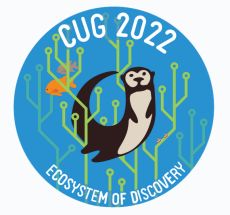CUG 2022: NERSC Hosts an ‘Ecosystem of Discovery’ in Monterey
April 26, 2022
The 2022 Cray Users Group (CUG) meeting, taking place May 2-5 in Monterey, California, will feature a number of papers and presentations that highlight the high performance computing (HPC) community's commitment to enhancing scientific productivity amid the emerging trend of increasingly complex scientific workflows and the impact on scientific discovery.
CUG was established in 1978 to facilitate collaboration and information exchange across the HPC community. In most years, CUG partners with a member site to select a location and theme for the annual meeting; this year, NERSC is the host site and chose the theme “Ecosystem of Discovery.” Nearly 200 attendees are expected from a broad range of organizations, including representatives from all DOE Office of Advanced Scientific Computing Research HPC facilities plus several academic institutions and the HPC industry.
“We have an exciting and diverse program at CUG 2022, with talks, tutorials, and Birds of a Feather sessions covering a range of software and hardware topics, including artificial intelligence, machine learning, new architectures, advances in storage and analytics, system management, scientific applications, and more,” said NERSC Application Performance Specialist Brandon Cook, who is currently vice president of CUG and the 2022 CUG program chair.
In addition to Cook, program committee members from NERSC include Johannes Blaschke, Tina Declerck, Helen He, Doug Jacobsen, Stephen Leak, Eric Roman, and Zhengji Zhao.
As part of the CUG 2022 technical program, Berkeley Lab staff are involved in a number of papers and presentations, including a keynote address on Wednesday, May 4 from Benjamin Nachman of the Lab’s Physics Division on “Machine Learning for Fundamental Physics.” In addition, Anna Ho - a postdoctoral fellow at UC Berkeley and a Berkeley Lab affiliate - is giving a keynote address, “The Landscape of Stellar Death,” on Tuesday, May 3.
Here is a day-by-day schedule of sessions that include Computing Sciences Area staff:
Monday, May 2
Birds of a Feather: “Programming Environments, Applications, and Documentation Special Interest Group Meeting,” Stephen Leak. 1:30 - 2:30 p.m.
Birds of a Feather: “HPC Support Documentation Management and Best Practices,” Stephen Leak. 3 - 5 p.m.
Tuesday, May 3
Technical session: “Slingshot Fabric Manager Monitor,” John Stile. 2 - 2:30 p.m.
Technical session: “Adopting Standardized Container Runtimes in HPC,” Aditi Gaur, Shane Canon, Laurie Stephey, and Doug Jacobsen. 3 - 4:30 p.m.
Technical session: “Improving a High Productivity Data Analytics Chapel Framework,” Costin Iancu. 3 - 4:30 p.m.
Birds of a Feather: “OpenACC Users Experience,” Soham Ghosh. 4:35 - 5:35 p.m.
Wednesday, May 4
Technical session: “Using Loki for Simplifying the Usage of Shasta Logs,” Siqi Deng. 4 - 5 p.m.
Thursday, May 5
Technical session: “Accelerating X-Ray Tracing for Exascale Systems using Kokkos,” Felix Wittwer, Nick Sauter, Derek Mendez, Billy Poon, Aaron Brewster, James Holton, Deborah Bard, and Johannes Blaschke. 8:30 - 9 a.m.
Technical session: “Fallout: System Stand-up Monitoring and Analysis Package,” Eric Roman. 8:30 - 10 a.m.
Technical session: “Crayport to HPE DCE Migration: Bidirectional Incident Management for ServiceNow and HPE DCE,” Daniel Gens, John Gann, and Elizabeth Bautista. 11 - 11:30 a.m.
Technical session: “Enabling Scientific AI at Scale on the Perlmutter System and NERSC,” Wahid Bhimji, Steven Farrell, and Peter Harrington. 1 - 2 p.m.
Technical session: “Network Integration of Perlmutter at NERSC,” Ershaad Basheer, Eric Roman, Tavia Stone Gibbins, Lisa Gerhardt, Doug Jacobsen, Ashwin Selvarajan, Damian Hazen, and Ronal Kumar. 1 - 2 p.m.
About NERSC and Berkeley Lab
The National Energy Research Scientific Computing Center (NERSC) is a U.S. Department of Energy Office of Science User Facility that serves as the primary high performance computing center for scientific research sponsored by the Office of Science. Located at Lawrence Berkeley National Laboratory, NERSC serves almost 10,000 scientists at national laboratories and universities researching a wide range of problems in climate, fusion energy, materials science, physics, chemistry, computational biology, and other disciplines. Berkeley Lab is a DOE national laboratory located in Berkeley, California. It conducts unclassified scientific research and is managed by the University of California for the U.S. Department of Energy. »Learn more about computing sciences at Berkeley Lab.








